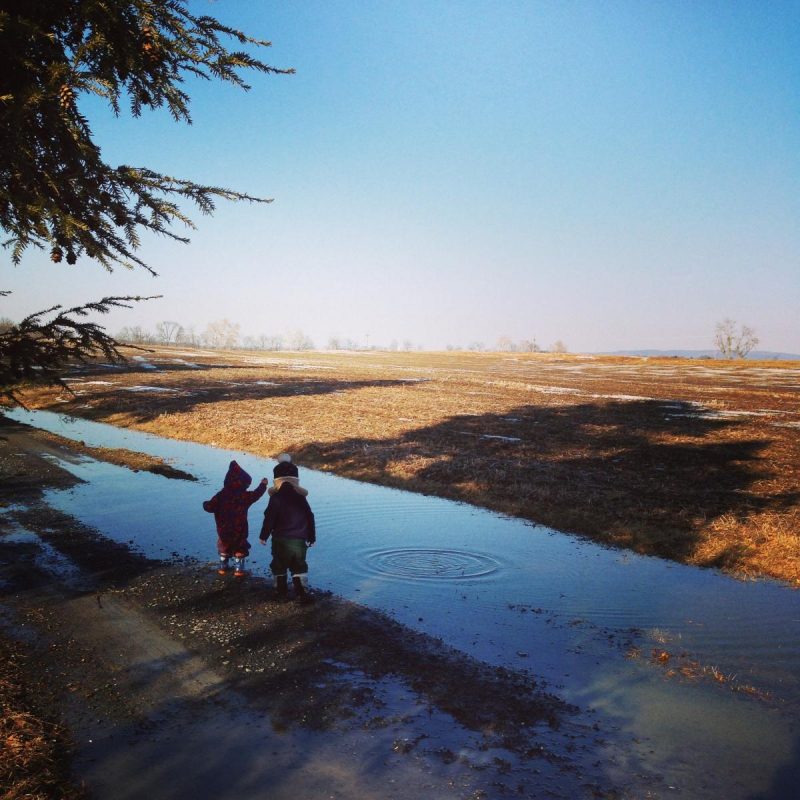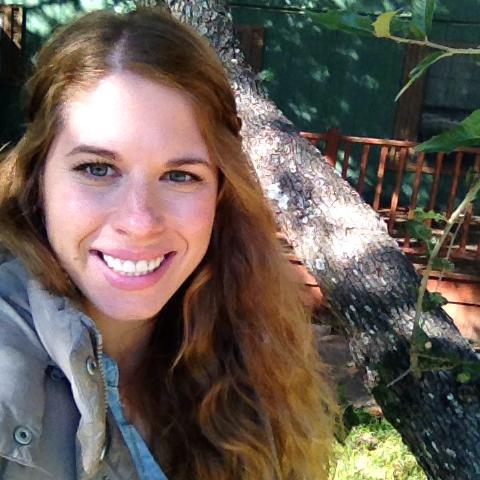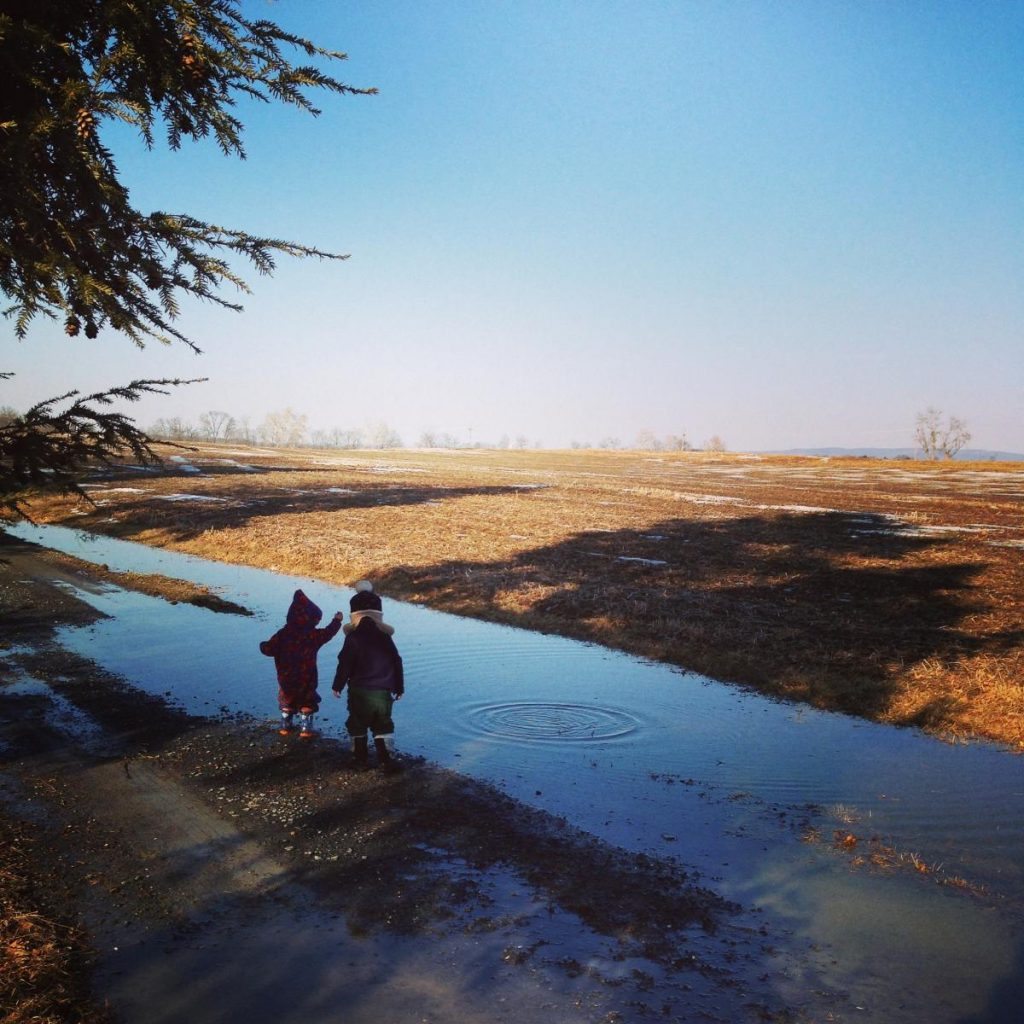 Audra writes: What if playgrounds were natural landscapes where children explore their outdoor surroundings and create their own play structures? What if children’s crafts were inspired by nature and made from natural materials? Can you imagine a world where the forest is a child’s classroom? What if a child’s curiosity was fueled by the world around them, unhindered by media and marketing? What would it look like? I am lucky. I don’t have to wonder! My children attend a Waldorf school and the area where I live in Austin has many different childcare and school options. My family is fortunate. Many children in our country do not experience the outdoors daily. For the more than 50 million children in public or secondary schools in the United States (NCES), only 19 to 27% of public schools today have recess(es) for more than 30 minutes each day. The majority of schools have far less (NCES). That means about 38 million children are outside for less than 30 minutes during the day! When children have recess, play is structured and restricted. Children need more time outside. The benefits of being outside are numerous. What if through our actions we could do our part to spread a movement of change throughout our country? More time spent at a desk does not equal smarter children. What if?
Audra writes: What if playgrounds were natural landscapes where children explore their outdoor surroundings and create their own play structures? What if children’s crafts were inspired by nature and made from natural materials? Can you imagine a world where the forest is a child’s classroom? What if a child’s curiosity was fueled by the world around them, unhindered by media and marketing? What would it look like? I am lucky. I don’t have to wonder! My children attend a Waldorf school and the area where I live in Austin has many different childcare and school options. My family is fortunate. Many children in our country do not experience the outdoors daily. For the more than 50 million children in public or secondary schools in the United States (NCES), only 19 to 27% of public schools today have recess(es) for more than 30 minutes each day. The majority of schools have far less (NCES). That means about 38 million children are outside for less than 30 minutes during the day! When children have recess, play is structured and restricted. Children need more time outside. The benefits of being outside are numerous. What if through our actions we could do our part to spread a movement of change throughout our country? More time spent at a desk does not equal smarter children. What if?
I run a childcare program called Majestic Oak, centered on children 18 months to 5 years of age. It’s very important that the children develop and foster a love of nature and not depend on standard commercial toys for outdoor play. At Majestic Oak we have seven wood stumps, a pile of logs in various sizes, a swing, and the children’s garden, with plans to slowly introduce new things such as a sandbox and some natural climbing apparatuses. When I opened Majestic Oak, some of the children the first day seemed bored and confused when brought outside for playtime. I just waited a few minutes to see if the children could come up with ways to have fun without my direction. About fifteen minutes into our outdoor time, a group of children started to dig in the dirt. When the two initially apprehensive children saw this, they walked over to the group, squatted next to them, and began to dig as well. A few minutes later they even began to lead the conversation and discussed what they were finding in the dirt. This interaction continued for 10 minutes before one of the two children approached me again. The child repeated that he was bored and wanted to go inside. I simply encouraged him to look around for something to do. He quickly found a pile of branches that were stacked next to a group of large tree stumps and asked what they were for. I said he could do anything with them and walked away so I could observe from a distance. He began pulling branches out of the pile and putting them on top of the logs. He worked on this for about 30 minutes, which drew the attention of the other children. Before long there was a group of children putting together structures. They continued building until lunchtime.
Upon further reflection, I realized that the same children who had a hard time coming up with activities in the yard also seemed to bounce from one activity to the next indoors, without really getting lost in play. After our childcare ended for the day, I looked for ways to work on encouraging self-directed imaginative play. I found an online article titled, “Kids don’t know how to play on their own anymore. Here are four ways to change that.” The four suggestions are as follows: First, encourage your child’s unique strengths. Second, encourage physical activity. Third, let your child play without intervention. Fourth, remember what it is like to be a child.
I also discovered a book called Heaven on Earth by Sharifa Oppenheimer. There I read some wonderful ideas about setting up spaces for the children to discover. Inspired by a section of the book called “Backyard Wildlife,” I decided to incorporate a craft that would help excite children in their outdoor surroundings. Before the children arrived I set up pinecone birdfeeders in the trees. When the children arrived, they made birdfeeders with pinecones, sunflower seed butter, and birdseed. While the children worked on their birdfeeders we talked about what they could do with them at home. After our craft we headed outside with cups of birdseed for each child. The children had fun spreading the seeds in the backyard and looking for birds. The birds were not flocking to the area, but that did not diminish the children’s enthusiasm. After we spent some time looking and listening for birds, the children went off to play. Like the day before, one of the children approached me and said he did not know what to do. I replied, “I wonder what you could do,” as I began walking about the yard. The child followed behind. I stopped when I got to the structure that he had started building the previous day. I let the child know how amazing the structure was and wondered aloud how many different structures could be made. The child responded with, “I can build a lot of things.” I walked away and wandered around the yard, humming a song. When I looked back, the child was taking apart the structure and putting together something new. When the structure was finished, all of the children played on the structure together. I noticed that the child who built the structure began to help direct the play in pretending that it was a boat. This was the first time I had seen this child participate in imaginative play. What I took away from this experience is that through a self-directed enjoyable and confidence-building activity, the child developed a strong sense of pride, which opened him up to further creative play. This child continued to become more comfortable with creative play throughout the rest of the semester.
I realized that I needed to bring more of nature inside as well, so the children could continue to build their connection with nature. I started by filling a basket with rocks, crystals, shells, and sticks, along with a magnifying glass. During the weekend while doing yard work, my husband Fred and I took down a few trees that were growing into our neighbor’s fence. We cut some of the branches into cylinders and logs for the children to build with. I placed them in a basket on the floor next to the basket of wooden blocks. We cut more rounds to make coat hooks for the children. When the children came back after the weekend I allowed them to discover the new additions to our indoor play space. I was excited to see the children find the toys and use their new building materials. The children combined the basket of wooden building blocks with the new building logs. Cities and towns took over the whole living room. The toy truck was full of logs being delivered to new building sites. The seashell became a boat in the town lake. The rocks became cars and the crystals became plants in a garden. Abstract play at its finest! I loved seeing how bringing a bit of nature into the house was so quickly incorporated into the children’s play. Bringing in such simple objects helped children expand their abilities for unassisted play and helped further their sensory experience.
I also wanted the children to connect with nature through gardening. We spent four weeks filling our raised garden bed with soil and preparing the garden. The kids took so much pride in watching their plants grow. Every week we pulled weeds and watered the plants. As the plants matured, the children enjoyed harvesting beans and tomatoes. It was amazing to watch the children eat and enjoy the results of their hard work. One vegetable we grew was beets. Each child helped pull the beets up. We cut them up and put them in the oven to roast. Some of the children had never tried beets before. I was surprised and excited to see that most of the children enjoyed them. Some only liked the greens and some enjoyed the red beets and others enjoyed the light colored beets, but all enjoyed some aspect. I think that by growing, caring for, and preparing the beets, the children developed a sense of connection to them. Their pride was so apparent. I felt like the kids were becoming one with nature and developing an understanding of the process from seed to food. These children worked hard and enjoyed the fruits of their labor!
Majestic Oak is an all-weather program. Part of connecting with nature is enjoying the changes in seasons and the unpredictable Texas weather. On our first rainy day together, we were excited to play in the mud and rain. All of the children enjoyed stomping in the puddles, making mud pies, and watching leaves float across the water that was rushing through my backyard. Leaves turned into boats traveling to far-off lands. Frogs and snails had taken over the yard. My business partner and I enjoyed watching the children collect snails in buckets and chase peeper frogs around the yard. I remember this being the day that I fully realized that all of the children were comfortable in their surroundings and excited about nature. No one was asking for direction or reassurance. This was their place and nature was their classroom.
In Freya Jaffke’s book Work and Play in Early Childhood, Freya writes about development during the first seven years of life. In the first two-and-a-half years the child concentrates on the development of the organs of the nervous and sensory systems. Freya also describes the formative life forces, which are working in the head during these early years. During this time children learn primarily through imitation and they develop skills like standing, walking, and speech. As a child grows from three to five years old, the formative life forces shift toward the middle part of the body. The rhythmical organs like the heart and lungs are developing. The imagination and memory developed during the earlier years are now being exercised. From five to seven years, the child develops fine motor skills and coordination as the formative life forces are working in the limbs. They are exercising their rhythm, playing in groups, and may find it difficult to use their imagination while seeking stimulation from others.
Interacting with young children on a daily basis provides an opportunity to observe the transitions described by Freya in her book. While caring for a twelve-month-old child outside, I observed her connect to nature through sensory experiences. She played in the soil and wiggled her toes in the soft dirt before sowing our garden seeds. She observed the other children, feeding off their excitement, and imitated the sounds they made. She enjoyed finding sticks to hold and falling asleep on my chest in the swing while listening to the leaves rustle in the wind. The older children used more imagination. A two-year-old hopped like a bunny. A three-year-old became the bunny and built a den to live in out of branches and leaves. The four-year-old added more details, like a fireplace because he knew that bunnies get cold. The six-year-old knew that a fireplace made of wood would burn in the fire, so he opted for stone. It was amazing to watch how everything in Freya’s book correlated so well with the children in our group. The older children were especially interesting to watch as they began to crave group activities, competition, pushing their limits, and attention to detail. The older children also had the ability to reflect and remember past experiences like planting seeds. Regardless of whether the memories were from the day before or several weeks prior, the recollections cultivated a positive experience of their time spent outdoors.
In closing, children come into this world and are inherently good from birth. The child is ever changing and developing. As caregivers, we are given an opportunity to encourage a love of nature, a love of oneself, the ability to care for others, and to care for the world we live in. We are our child’s first teacher, and developing a love of nature within ourselves is a great way to begin fostering a love of nature in the young child.
 Audra Harvey is a graduate of LifeWays Austin. She is originally from the Northeast and has lived all over the United States. She is a wife and mother to three girls who attend their local Waldorf school. While working on the kindergarten playground, Audra realized that she was called to work with young children full time. She runs a home program, spending her days sharing with the children all that she has learned through LifeWays.
Audra Harvey is a graduate of LifeWays Austin. She is originally from the Northeast and has lived all over the United States. She is a wife and mother to three girls who attend their local Waldorf school. While working on the kindergarten playground, Audra realized that she was called to work with young children full time. She runs a home program, spending her days sharing with the children all that she has learned through LifeWays.
